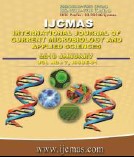


 National Academy of Agricultural Sciences (NAAS)
National Academy of Agricultural Sciences (NAAS)

|
PRINT ISSN : 2319-7692
Online ISSN : 2319-7706 Issues : 12 per year Publisher : Excellent Publishers Email : editorijcmas@gmail.com / submit@ijcmas.com Editor-in-chief: Dr.M.Prakash Index Copernicus ICV 2018: 95.39 NAAS RATING 2020: 5.38 |
Marigold, a member of the Asteraceae family is one of the five most commonly cultivated and used flower in urban and rural India for decorations and religious functions. The leaves and flowers possess medicinal value having phenolics and antioxidants. Although these plants are relatively easy to grow, but are susceptible to many fungal and bacterial diseases. During the year 2016, African marigold (Tegetes erecta L.) plants grown at KVK Kandaghat were found infected with a leaf spotting fungus i.e. Septoria sp. in the months of July-August. The initial symptoms are small, water-soaked circular spots on older leaves. The centers of these spots gradually turn gray to tan and have dark brown margins. The severity of the disease ranged from 30-70 per cent in marigold growing areas of the district and under favourable environmental conditions may go upto 100 per cent. During microscopic examination, dark, globose, ostiolate and erumpent pycnidia were observed. The conidia were hyaline, narrowly elongate to filiform, measuring 25.2-48.7µ in length and 1.04 to 2.98µ in breadth with an average of 39.2 x 2.0µ under 400x magnification. The associated pathogen was isolated in pure form. The colonies were initially white, later on develop slight brown tinge with irregular margins.
 |
 |
 |
 |
 |